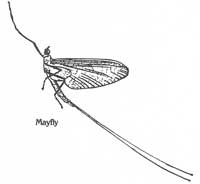Ephemeroptera: Mayflies
(from the Greek: ephemeros = living but a day)
Mayflies are small- to medium-sized, soft-bodied insects with incomplete metamorphosis. Mayflies have undeveloped chewing  mouthparts, 2 or 3 thread-like abdominal tails, and short, bristle-like antennae. The wings are membranous, with many cross-veins, and the hind pair is much smaller than the front pair. (Note that some small species have only one pair of wings, but most species have two pairs of wings.) Immature mayflies, called “naiads,” are aquatic. Mayflies have an unusual life-cycle: they molt after they grow wings. Most insects stop molting (shedding their skins) after they become winged-adults, but mayflies undergo one additional molt. The winged mayfly that emerges from the naiad has hairy wings and is called a "dun," or a “subimago.” After a brief period, the subimago molts to produce the “imago,” which has clear wings. The subimago is not a true adult - only the imago is able to mate. Mayfly adults live only a short time, usually less than one week. The development of the naiad is much longer, taking 1 to 3 years.
mouthparts, 2 or 3 thread-like abdominal tails, and short, bristle-like antennae. The wings are membranous, with many cross-veins, and the hind pair is much smaller than the front pair. (Note that some small species have only one pair of wings, but most species have two pairs of wings.) Immature mayflies, called “naiads,” are aquatic. Mayflies have an unusual life-cycle: they molt after they grow wings. Most insects stop molting (shedding their skins) after they become winged-adults, but mayflies undergo one additional molt. The winged mayfly that emerges from the naiad has hairy wings and is called a "dun," or a “subimago.” After a brief period, the subimago molts to produce the “imago,” which has clear wings. The subimago is not a true adult - only the imago is able to mate. Mayfly adults live only a short time, usually less than one week. The development of the naiad is much longer, taking 1 to 3 years.
In the Midwest, especially in the Great Lakes region, these insects often emerge in great hordes and can be a nuisance. They cover the sides of buildings, sidewalks, and streets to the extent that walking and driving are difficult. Despite the nuisance they sometimes cause, mayflies are valuable as food for many fishes. The immature forms are often sold in fish bait stores as "wigglers."

